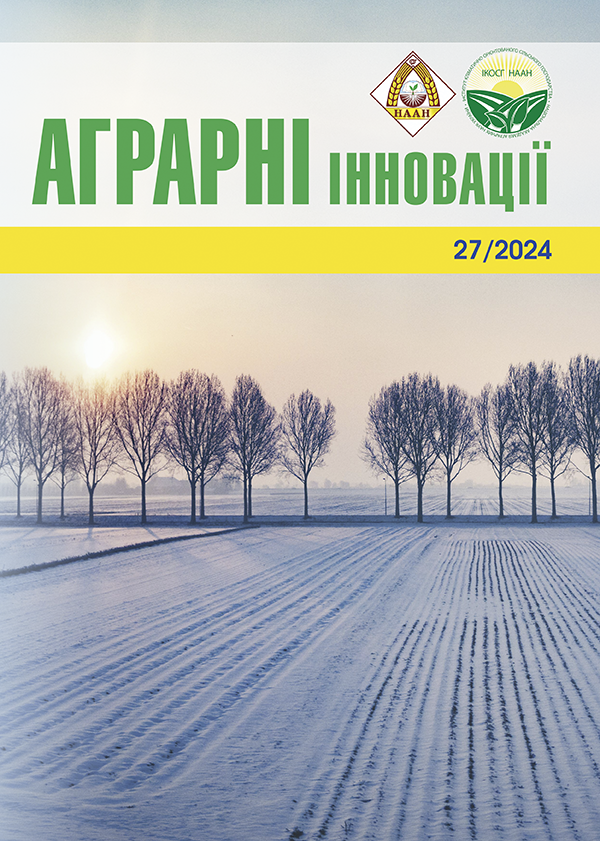THE INFLUENCE OF GROWING TECHNOLOGY ON THE DEVELOPMENT OF DISEASES OF CORN HYBRIDS IN THE CONDITIONS OF THE NORTHERN STEPPE OF UKRAINE
Abstract
Purpose. To study the influence of corn cultivation technology on the phytopathological state of the soil and the development of crop diseases in the conditions of the Northern Steppe of Ukraine. Methods. Field and laboratory research was conducted in accordance with modern requirements and standards of research in agronomy and agriculture. these studies made it possible to objectively assess the influence of various factors of corn cultivation technology on its development, health and phytosanitary condition. The results Growing corn using no-till technology, with plant residues left on the soil surface, during all the years of research, contributed to changing ecological conditions that affected the formation and development of microorganisms in the soil. according to the results of phytopathological analysis of soil samples, the total number of fungi ranged from 72.9 to 92.6 thousand. CFU/g of soil. The increase in the number of all groups of microorganisms in the soil contributed to the natural biological control of the number and development of pathogens of corn diseases. all corn hybrids, regardless of the experiment variant, were affected by the fungi Sphacelothecareiliana Clint, Diplodia zeae and Fusarium verticillioides (Sacc.) Nirenberg. On average, over the years of research and according to the variants of growing technologies, the plants of the hybrid DKS 3730 were more affected by pathogens of flying soot and diplodiosis, and the intensity of disease development in the flowering phase and the grain filling stage was higher by 15.2 and 4.9 percentage points, respectively, compared to hybridoma DKS 4795.however, the hybrid DKS 3730 proved to be more resistant to Fusarium head blight: the intensity of disease development was lower compared to the hybrid DKS 4795. The same trend was maintained during grain ripening. with regard to cultivation technology, it was found that in all years of research, the conditions created by no-till technology contributed to better growth and development of plants, which, in turn, increased their resistance to diseases. Conclusions. The average value of the total number of fungi in the soil samples of the research plots over the years of research ranged from 72.9 to 92.6 thousand. CFU/g of soil, with the advantage of the no-till technology option. The proportion of pathogenic fungi in soil samples using this technology was on average 6.9 thousand. kUO/g of soil, which is a lower indicator compared to the version of the classical corn cultivation technology. Studies have shown that the increase in the number of all groups of microorganisms in the soil contributed significantly to the natural biological control of the number and activity of pathogens of corn. on average over the years of research and for each factor, the intensity of damage to plants by the fungi Sphacelothecareiliana Clint, Diplodia zeae and Fusarium verticillioides (Sacc.) Nirenberg was lower compared to the classical technology, depending on the phase of plant growth and development.
References
2. Лихочвор В. В., Петриченко В. Ф., Іващук П. В. Зерновиробництво. Львів: НВФ «Українські техноло- гії», 2008. 624 с.
3. Базілєва Ю. С. Особливості ураження збудниками хвороб насіння кукурудзи залежно від його стану. Бюлетень Інституту сільського господарства степової зони НААН України. 2015. № 9. С. 96-99.
4. Грикун О. Найважливіші шкідники кукурудзи в Україні. Пропозиція. 2007. № 5. С. 70-78.
5. Деревенець К. А. Якщо посіяли із запізненням. Ураженість кукурудзи хворобами та пошкодженість шкідниками за різних строків сівби. Карантин і захист рослин. 2012. № 6. C. 17–18.
6. Баннікова К. В., Шевчук О. В. Пухирчаста сажка кукурудзи. Карантин і захист рослин. 2011. № 4. С. 15–16.
7. Бєлов Я. В. Удосконалення технології вирощування гібридів кукурудзи в умовах південного Степу України : автореф. на здобуття вченого ступеня канд. с.-г. наук за спеціальністю : 06.01.09 «Рослинництво». Миколаїв, 2020. 24 с.
8. Борзих О. І. Хвороби рослин основних польових культур в агроценозах України. Біоресурси і природокористування. 2015. Т. 7. №. 1–2. С. 183–189.
9. Вплив агротехнічних прийомів на продуктивність та якісні показники зерна кукурудзи / Вожегова Р. А., Дробіт О. С., Шебанін В. С. Дробітько А. В. Науково практичні основи формування інноваційних агротехнологій – новітні підходи молодих вчених : зб. матер. міжнар. наук.-практ. online конф. молодих вчених. Херсон : ІЗЗ НААН, 2020. 48–49 с.
10. Вох В. М., Антоненко О. Ф., Галиш Ф. С. Поширення і розвиток гельмінтоспоріозу в зонах вирощування кукурудзи. Науковий вісник Національного університету біоресурсів і природокористування України. 2012. № 176. С. 296–300.
11. Дерменко О. Бура плямистість кукурудзи. Пропозиція. 2011. № 1. С. 80-82.
12. Дробітько О. М. Особливості формування продуктивності кукурудзи залежно від просторового і кількісного розміщення рослин в агрофітоценозі в умовах південно-західного Степу. Корми і кормовиробництво. 2008. Вип. 60. С. 62–68.
13. Захист кукурудзи від шкідників і хвороб / В. В. Кириченко, В. П. Петренкова, А. Г. Гур'єв та ін. Посібник українського хлібороба. К., 2008. С. 14–31.
14. Іванів М. О. Морфофізіологічні показники гібридів кукурудзи залежно від ґрунтово-екологічного пункту. Зрошуване землеробство. 2012. №. 57. С. 86–92.
15. Каламбет В. Кукурудза vs летюча сажка. Agroexpert. 2016. №12 (101). URL: https:agroexpert.ua/kukurudzavs- letuca-sazka/ (дата звернення: 10.10.2024). 16. Каленська С. М., Таран В. Г., Данилів П. O. Особливості формування урожайності гібридів кукурудзи залежно від удобрення, густоти стояння рослин та погодних умов. Таврійський науковий вісник. 2018. №. 101. С. 42–49.






